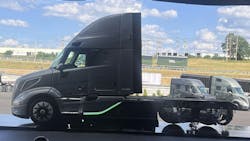Volvo teases upcoming VNL Electric truck during diesel VNL event
DUBLIN, Virginia—With its safety features, fuel-efficient design, and its connectivity capability, the new Volvo VNL could become the safest, most fuel-efficient Class 8 truck on the market. The VNL platform was designed to be used in Volvo’s future trucks powered by alternative power systems, and while the truck has yet to make it into the hands of owners—deliveries begin in October—Volvo has already announced the next power system to be used in the all-new VNL.
Volvo offered a quick, distant look at the VNL Electric prototype at the close of a media event featuring a deep dive into the all-new VNL. A curtain hiding the vehicle lifted just long enough for media to take photos before lowering again, and Volvo executives took no questions.
What we know about the VNL Electric
Devoting only five sentences specifically about the VNL Electric in the announcement, the upcoming truck is shrouded in mystery. But here’s what we know:
VNL Electric Quick Facts
- Sales begin in late 2025
- Assembled in the U.S. at Volvo’s New River Valley facility
- The VNL Electric will replace the VNR Electric as Volvo’s flagship electric truck
Volvo announced the brand will begin selling the upcoming Class 8 electric truck in late 2025. Just like the ICE-powered VNL, the VNL Electric will be assembled at Volvo’s New River Valley plant in Dublin, Virginia. Within one of those five sentences, Volvo announced that the VNL Electric will be the "flagship of North America's bestselling line of heavy-duty battery electric trucks.”
What does this mean for Volvo’s current heavy-duty battery electric vehicle, the VNR Electric? There are nearly 1,000 VNR Electric trucks currently in operation in the U.S. and Canada, and the truck enables Volvo to hold 43.8% of the market share for the heavy-duty electric truck segment.
“The VNR Electric will continue to be available until the VNL Electric makes its debut,” according to the Volvo announcement.
During the event, Volvo outlined continued investments in its EV future. It’s ramping up its EV-certified dealers to continue supporting the VNR Electric and support the VNL Electric once it’s available. The brand currently has 62 completed Volvo Trucks’ certified EV dealers and 40 in progress. In addition, the brand recently acquired the battery business from Proterra.
While Volvo shared no details about the VNL Electric, one could infer that the truck will share many of the same features as its ICE counterpart, the recently debuted all-new VNL.
See also: Volvo Trucks launches On Demand EV adoption service
Road to electrification
In February, shortly after the new VNL was announced, FleetOwner reported that the truck will be the platform for future Volvo power systems, “including battery-electric, fuel-cell electric, and renewables, as well as hydrogen.”
The new generation VNL was developed and designed to be more competitive and more “future proof,” according to Magnus Koeck, VP of strategy, marketing, and brand management at Volvo Trucks North America. While Volvo announced the development of the VNL Electric before it even delivered the first ICE-powered VNL, it’s having this all-new ICE product in operations that could usher in the adoption of the VNL Electric and those additional alt-fuel and alt-power system vehicles.
Because the VNL was designed with future power system developments in mind, perhaps it’s this strategy that will help more fleets adjust to upcoming emissions regulations.
With federal Environmental Protection Agency rules and local and state regulations down the pipeline, the trucking industry is forced to adjust. Unfortunately, many fleets can’t make a business case for purchasing trucks with alternative powertrains as their costs are higher, and the time it takes to implement them could result in lost productivity. However, improvements to diesel-powered vehicles, even small, can make an impact on fleet efficiency and the environment.
See also: Volvo sees fleet profitability paved upon its path to zero
Volvo has proved this with its all-new VNL, which has been 90% redesigned from the previous generation, resulting in a truck that’s 10% more fuel efficient. This could result in a savings of more than $5,000 per truck per year.
Volvo explained the math this way: Consider a truck has an annual mileage of 120,000 miles. A previous generation VNL truck gets 8 mpg, while the all-new VNL gets 8.8 mpg. This means a previous generation VNL will burn 15,000 gallons of fuel, whereas the new VNL will burn only 13, 636, resulting in a savings of 1,364. If each gallon of fuel costs $4, that’s an annual savings of $5,456.
Further, adding a new VNL to their operations could give fleet owners a more probable taste of the future. Once Volvo’s VNL Electric is available, having an electric heavy-duty option built on the same platform and with similar features as a fleet's current vehicles could also simplify the transition to EVs.
About the Author
Jade Brasher
Senior Editor Jade Brasher has covered vocational trucking and fleets since 2018. A graduate of The University of Alabama with a degree in journalism, Jade enjoys telling stories about the people behind the wheel and the intricate processes of the ever-evolving trucking industry.


